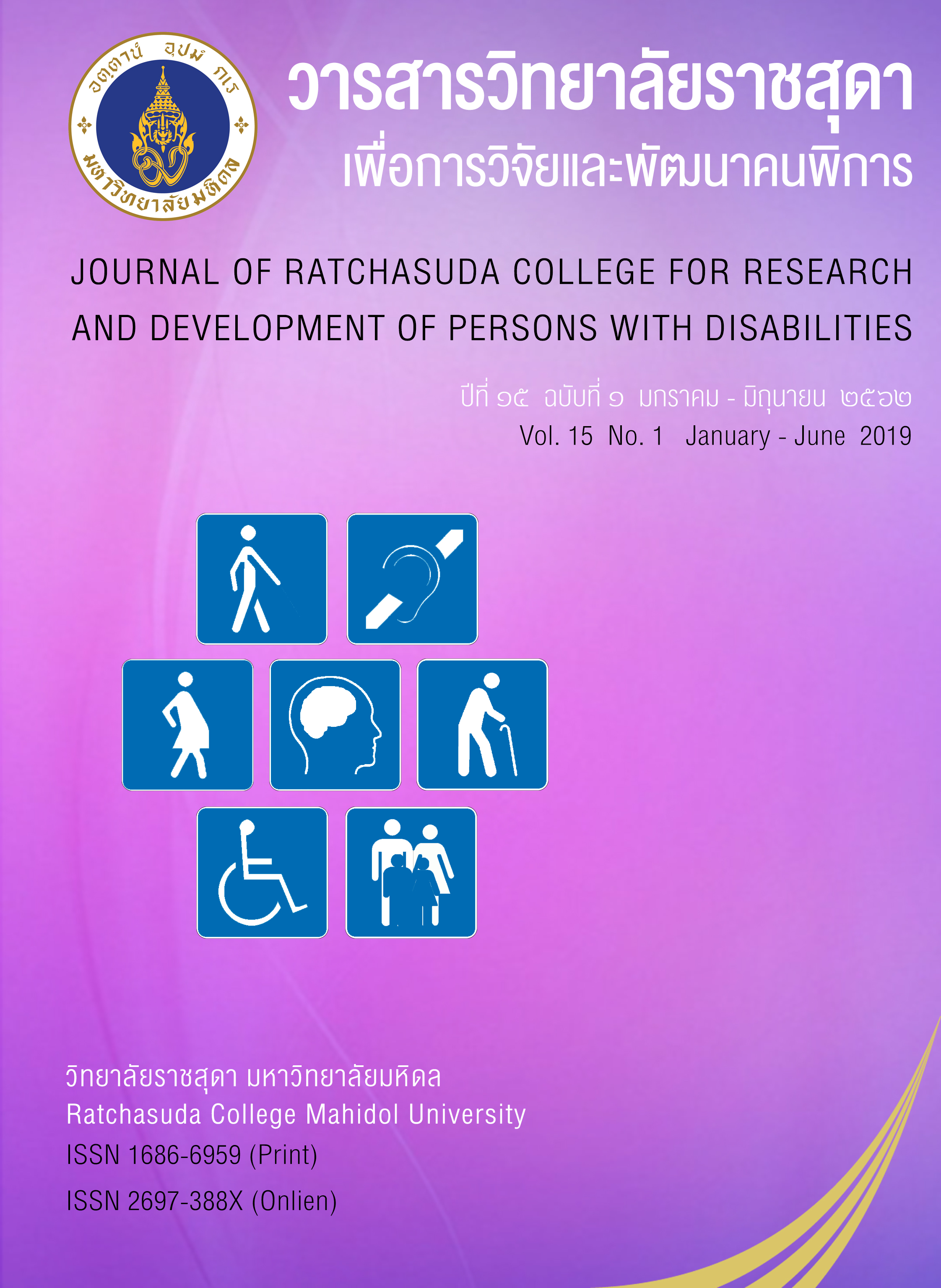Factor Analysis and Classification of Travel Behavior of Physically Disabled
Keywords:
Physically disabled, Behavior, Factor Analysis, ClusteringAbstract
The objectives of this research were to investigate the tourism behavior of the physically The objectives of this research were to investigate the tourism behavior of the physically disabled in order to group the travel factors. The populations used in this study consist of 238 students of School and vocational students. Data collection was completed through questionnaire distributed during July 1-15, 2018. The research tool was a questionnaire developed based on marketing mix and service framework. For extracting factor, the Principle Component Analysis was performed by rotating the Orthogonal Rotation axis with Varimax with Kaizer Normalization. For travel behavior of persons with physical disabilities we apply K-Means for group analysis.
The research was found that the physically disabled often travel within the country about 1-3 times a year. They usually take about 1-2 days to travel which Saturday and Sunday are the The research was found that the physically disabled often travel within the country about 1-3 times a year. They usually take about 1-2 days to travel which Saturday and Sunday are the days to travel. The average cost Expense of travel is about 1,001-2,000 Baht. From the classification of tourism behavior factors, they can be divided into 2 groups: 1) travel packages and 2) supplemental services. To promote the tourism of physically disabled, they should publish information about tourism which is mainly a natural source with beautiful scenery. In particular, they should have organized travel packages that are beneficial to physically-challenged. In addition, they should increase any facilities for physically disabled such as first aid unit in tourist area or nearby hospital around tourist area. In addition, they should provide travel guides for the physically disabled.
Downloads
References
Chobkhay, S., Khamsa-ard, S., & Siriwong, P. (2018). Strategic Development to Develop Tourism for People with Physical Disabilities and Seniors of Ubon Ratchathani Province. Dusit thani College Journal. 12(2).
Darcy, S., & Dickson, T. (2009). A Whole-of-Life Approach to Tourism: The Case for AccessibleTourism Experiences. Journal of Hospitality and Tourism Management, 16(1), 32-44.
Department of Empowerment of Persons with Disabilities. (2018). Report of Person with Disabilities Data in Thailand: 31 march 2018. [In Thai]. Retrieved from http://dep.go.th/ sites/default/files/files/news/Report_PWDS_SEP2018.pdf.
Loureiro, S. M. C. (2014). The role of the rural tourism experience economy in place attachment and behavioral intentions. International Journal of Hospitality Management, 40, 1-9.
Ministry of Social Development and Human Security. (2017). Retrieved from http://www.m-society.go.th
One La, A. (2010). The creation of the technology of the senator’s identity, the visually impaired. thesis Master of Arts Public and private management Silpakorn University.
Ounvijit, C., Sirisarn. Y., & Rongsa-ard. P. (2014). Guidelines for Recreation and Tourism Development for the People with Disabilities in Chiang Rai Province. Journal of Ratchasuda College for Research and Development of Persons with Disabilities, 10(13).
Pairoj-Boriboon, T. (2016). Disability Study under Inclusive Tourism Trends. Journal of Social Development, 18(1), 103-122.
Pasunon, P. & Wiriyawuttikai, K. (2010). “Factors and Behavior of Silpakorn University Phetchburi IT Campus’s Students to Worship to Ganesha”. Srinakharinwirot Research and Development (Journal of Humanities and Social Sciences), 6(3), 27-38.
Promotion and Development of the Quality of Life of Persons with Disabilities B.E. 2550. (2007). Government Gazette, 124(61A). 8-24.
Samaneein, K. (2017). Improving Tourism for Travellers with Mobility Impairment Faculty of Science: Ubon Ratchathani Universirty. The 9th International Conference on Disability 2017.
Siriratraykha, T. (2011). People with disabilities and social opportunities. Accessed on 2 June. Accessible from http://www.happyhomeclinic.com/academy/dp01opportunity.pdf. Ministry of Education Announcement, B.E. 2552. (2009). Government Gazette, 126(80), 45–47.
Trongjitpituk, T. (2013). Tourism Behaviors of Person with Physical Disability in Bangkok Metropolis and Vicinity. Master of Science. Sport Science: Faculty of Sports Science: Chulalongkorn University.
World Health Organization. (2011). World Report on Disability.WHO Press: Switzerland: 1-14.
World Tourism Organization. (2016). Global report on the power of youth travel: Volume thirteen. Madrid: Author.
Yala Provincial Socail Development And Human Security Office. (2014). Benefits for the disabled People with disabilities and benefits received. Accessed on 3 June. Accessible from http://www.yala.m-society.go.th/?cat=3.
Downloads
Published
How to Cite
Issue
Section
License
บทความที่ได้รับการตีพิมพ์เป็นลิขสิทธิ์ของวารสารสถาบันราชสุดาเพื่อการวิจัยและพัฒนาคนพิการ






